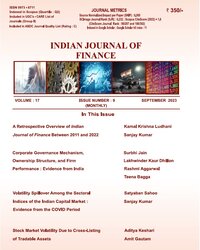Analysis of Financial Performance of Selected Public and Private Sector Banks
Subscribe/Renew Journal
.The commercial banks have played a vital role in depicting the financial system of any country. The health of any country can be defined by the condition of the financial system which is going to be reformed. Reforms have been done from time to time on the ground of several committees introduced in the banking sector such as the first Narasimham Committee (1991), Verma Committee (1996), Khan Committee (1997), second Narasimham Committee (1998). The growth and efficiency of the country can be determined through the financial performance of the banks. The main task of this paper was to do a comparative analysis of the financial performance of selected public sector and private sector banks. Besides this, the study tried to acknowledge the financial stability, liquidity, profitability, and other financial aspects of the banks. For the study purpose, three public sector banks (State Bank of India, Bank of Baroda, and Punjab National Bank) and three private sector banks (HDFC Bank, ICICI Bank, and Axis Bank) were chosen as they have the largest financial base. The overall study is based on the secondary data collected from the annual reports, newspapers, magazines, and online sources for the period of 5 years from 2015-2019. It was found from a comparative analysis that the public sector banks have made a significant progress, but they still do not meet the performance benchmark set by the private sector banks. Private sector banks (2.02300%) were found to be more successful in controlling the non-performing assets (NPA) in comparison to the public sector banks (5.12133%).
Keywords
Commercial Banks, Social Base, Financial Performance, Profitability, Liquidity.
User
Subscription
Login to verify subscription
Font Size
Information


